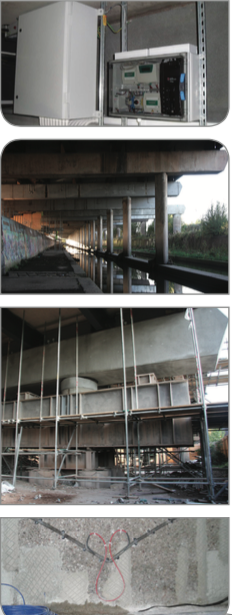 Cathodic protection installation and concrete repairs
Cathodic protection installation and concrete repairs
Client
Highways Agency Area 9 Framework
Principle Contractor
Amey
Civils Specialist
Osborne Limited
Value
£750,000
Works Commenced
January 2011
Works Completed
December 2011
Bromford Viaduct is one of a number of viaducts forming the Midland Link Motorway Viaducts (MLMVs). There are 21km of elevated motorway comprising 1200 no. cross beams and 3600 no. columns, constructed between 1969 and 1972. During the mid 1980s, corrosion started to occur due to de-icing salts leaking through deck expansion joints onto cross beams. Initial preventative measures, such as placing gutters beneath the expansion joints, were implemented during the mid to late 1980s and repair works in 1990. Concrete repair and cathodic protection installation schemes have been on-going to the present day based on calculated intervention dates for each cross beam. Repair Contract 153 (R153) commenced in January 2011 and comprises of 8 no. cross beams.
Freyssinet was appointed as a specialist contractor within the Highways Agency Area 9 &10 CMF. The scope of works involved removing sections of concrete to be repaired by saw cutting and hydrodemolition. Repairs were carried out as necessary to reinforcement steel and the areas re-instated using flowable concrete, with some beams repaired under a supported condition.
Galvanic (Sacrificial) anodes were installed to 2 no. beams, whilst the remaining 6 no. beams had an Impressed Current Cathodic Protection (ICCP) system installed. The ICCP was designed as a 3 no. zone system; zone 1 being a ribbon mesh primary anode with a spray applied conductive overlay, and zone 2 and 3 a ribbon mesh anode with non-conductive repair mortar overlay.
Technical issues which prevented supporting steel work being erected to the underside of 2 no. cross beams threatened to cause delays to the programme, and Freyssinet’s installation of the CP system. Successful cooperation between all parties resolved this situation, and the works were re-sequenced to enable Freyssinet to begin cathodic protection installation works ahead of programme by utilising concrete curing periods where there was no other activity taking place in the work area.
The designers also re-sequenced concrete repair works so that as far as practical, whichever half of each beam needing least repair was concentrated on in initial repair stages and would be complete in advance of the other half of beam, freeing up nearly 50% of CP installation work to be done before completion of concrete repairs.
Utilising Freyssinet’s own in-house hydrodemolition team contributed to the success of the new programme. Where concrete surface hydro-prep was required for overlay material, the team was able to mobilise immediately, taking advantage of short durations of concrete curing time, all the time pulling back the programme.
The cathodic protection on R153 was commissioned with performance verification taking place 45 days after ‘switch-on’ in early December 2011.
Successful cooperation between all parties resulted in the programme being pulled back to mid December 2011, offering the client savings in terms of both time and money.
